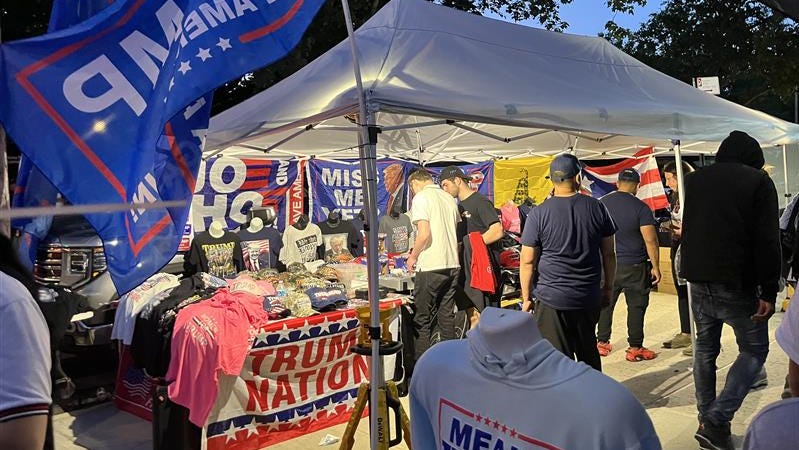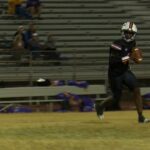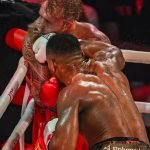NEW YORK — Upon exiting the closest subway station to former President Donald Trump’s campaign rally in the Bronx Thursday evening, the only signs of anything unusual were the NYPD officers at the turnstile with bomb-sniffing dogs and a helicopter buzzing overhead. There wasn’t a single piece of Trump paraphernalia on the New Yorkers filing out of the station.
But upon arriving at Crotona Park, a sprawling green expanse in the impoverished borough, red “Make America Great Again” hats and all manner of Trump-emblazoned apparel covered the bodies of thousands — even “Team Trump” cowboy hats. And in his address to the mostly non-white audience, Trump showed that he will readily depart rhetorically from Republican orthodoxy to find common ground.
Outside the park, a small band of protesters sporting Palestinian and Puerto Rican flags chanted “All the people from the Bronx say, ‘F— Trump!'” But their signs also proclaimed “F— Biden!”
They refused to answer who, if anyone, they were supporting.
Prep for the polls: See who is running for president and compare where they stand on key issues in our Voter Guide
The snaking line to enter the area cordoned off for the rally by police barricades was filled with enthusiastic Trump supporters, who cheered and gaped when they spotted his motorcade. Once he took the stage, the crowd went up on their tippy toes, arms upright with cellphone cameras aloft, hoping to catch just a glimpse of him.
“Hello to all the strong, hard-working American patriots right here in the Bronx,” Trump said, after bragging about the long lines to get in. “Who would think?”
A pitch for New York’s votes, with Democratic talking points
New York City itself was a major focus of Trump’s remarks, which included extended reminiscence about his renovations of a local skating rink and a golf course.
Trump frequently depicts New York as suffering from criminality unleashed by progressive governance. But he combined those talking points with an olive branch, of sorts, to the city he so frequently bashes.
If he retakes the White House, he promised: “I’m going to call your mayor and your governor and I’m gonna say, ‘I wanna help.'”
New York City’s murder rate dropped by 11.9% last year when its 386 homicides were roughly one-seventh of its 1990 peak. And its astronomical cost of living indicates robust demand to live there.
But one wouldn’t know it from Trump’s remarks, which repeatedly cast the city as beset by an unprecedented crime wave and general deterioration.
“Sadly, this is a city in decline,” he declared. “I’ve never seen it like this. We have filthy encampments of drugged-out homeless people living in our places where we spent so much time with our children that they used to play, lunatics killing innocent bystanders by pushing them on the railroad tracks.”
To address that, he promised to deliver results that could just as easily have been offered by a Democrat.
“We are going to turn New York City around,” Trump said. “We’re going to bring safety back to our streets, we’re going to bring success back to our schools. We’re going to bring prosperity back to every neighborhood in every borough of the greatest city of our land.”
“We’re going to make New York bigger, better and more beautiful than ever before, and that includes right here in the Bronx and it’s going to be done and funded, starting on Jan. 20, directly from our great and beautiful White House,” he added.
Later, Trump lamented that “our subways are squalid and unsafe,” and pledged to “make it beautiful again.” He also added: “We’re going to do what it takes to fix our roads and bridges.”
The Biden administration, which enacted a $1.2 billion infrastructure law that included money for the subway system, clapped back on X, saying that Biden is already doing what Trump proposes.
But the audience, many of whom said that Biden has done nothing in office, cheered Trump’s lines with enthusiasm.
More typical Republican positions were left mostly undiscussed. There was no mention of abortion, just one passing reference to tax cuts, and no discussion of Trump’s openness to cutting Social Security and Medicare.

An unlikely location for a Republican rally
The Bronx would not seem like hospitable territory for Trump, who won just 14% of its votes in 2020. It is 28% Black and 56% Latino — two groups that have historically favored Democrats by wide margins.
Nor is it in a swing state. New York favored President Joe Biden over Trump 61% to 38% in the last election.
But Trump is trying to squeeze in campaigning during his criminal hush money trial in neighboring Manhattan, so he has been making campaign appearances in his former hometown, such as stopping at a Harlem bodega to attack Manhattan District Attorney Alvin Bragg over crime last month.
There are signs that Trump has some potential to improve his standing. His 2020 performance was an improvement from 2016, when he won just 10% in the Bronx. That was similar to shifts nationally that showed movement toward Trump among voters of color, particularly Latinos and especially Latino men. This year, polling has shown Trump with a greater share of Latinos and young voters than he had in previous elections, although there are also signs that support is slipping.
The crowd seemed to reflect those demographic changes: It skewed young and heavily male, and while it was much more white and less Black than the Bronx, Hispanics were very well-represented.
Pedro and Gina Dominguez, Dominican immigrants who live in New Jersey, came to show their support for Trump. Like every other attendee interviewed, their reasons for backing Trump were based more on personality than policy.
“The United States needs a strong man to command our country and I believe Trump is the person,” Pedro Dominguez said. Gina Dominguez added that many of her friends who criticized her for supporting Trump in 2020 are leaning towards voting for him now because of inflation.

How it fits into Trump’s campaign strategy
Throughout his remarks, Trump tied his typical talking points to his appeal to the local market. When inveighing against migrants, for example, Trump argued that the groups hurt most by immigration are Blacks and Hispanics.
Trump also sharply criticized the Iraq invasion, which he falsely claimed to have opposed before it began.
And he predicted that he would successfully win over New Yorkers.
“Who said we’re not gonna win New York?” Trump asked rhetorically. “We’re gonna New York City. If we win New York, we win the whole thing.”
But while Trump’s advisors might know better than to think he can win the Empire State or Black and Latino voters outright, the image of him campaigning there could still help him among swing voters.
In what pundits sometimes refer to as a “ricochet pander,” reaching out to inner-city voters of color could benefit Trump among white suburban moderates by softening his image as racially divisive. According to National Review’s Ramesh Ponnuru, the classic example of this tactic is “when Republicans put a lot of black people on stage at their conventions in the expectation not that many black voters will join the GOP as a result but that some white voters will vote GOP because they see an effort being made.”
Election 2024:Trump, Biden spar over whether Trump’s 30-second pause was intentional or a ‘glitch’
Local elected officials react negatively
Rep. Ritchie Torres, D-N.Y., represents the congressional district in which Trump’s rally was held, the poorest in the country. Young, gay, Afro-Latino, and a self-identified progressive, he is seemingly Trump’s polar opposite.
On Thursday morning, Torres held a news conference in which he assailed Trump as a “fraud.”
“The South Bronx has no greater enemy than Donald Trump, who is on a mission to dismantle the social safety net on which Bronx families depend for their survival,” Torres said in a statement. “The South Bronx—the most Democratic area in the nation—will not buy the snake oil that he is selling.”
A counterrally was held at the same time in the same park, organized by Bronx Democratic state Assembly Member Amanda Septimo, civil rights activist Kirsten John Foy, and labor unions.
“I’m trying to talk some sense into these idiots,” said Rick Caballero, a Bronx resident and counter-protester. “Donald Trump is only for white people.”
Limited local support
The only elected official to share the stage with Trump was Rep. Byron Donalds, a Florida Republican who grew up in Brooklyn.
But Ruben Diaz, Sr., a conservative Democrat from the Bronx who represented the borough on the City Council and in the state Senate, came up onstage to laud Trump after his speech. Diaz has stirred controversy in New York with homophobic remarks and by welcoming Sen. Ted Cruz to the borough in 2016.
“As a Puerto Rican, as a Hispanic, I want to apologize to you for the conduct of Judge Juan Merchan,” Diaz told Trump, referring to the judge in Trump’s trial for allegedly falsifying business records to cover up payments to porn star Stormy Daniels. (Trump attacked Merchan as “crooked” and “conflicted” during his speech, although he didn’t specify what was “crooked” and the New York State Advisory Committee on Judicial Ethics found Merchan has no conflict of interest.)
Diaz concluded his remarks with an endorsement, which Trump said was unexpected.
“This Democrat, this Black Puerto Rican, with kinky hair and broken English: please accept my endorsement for president,” Diaz declared.
“He can’t even speak right, and he’s got millions and we’re broke,” joked Joe Walsh, a middle-aged attendee, in response to Diaz.
But, Walsh later added, “He’s probably the smartest Democrat because he’s for Trump.”












